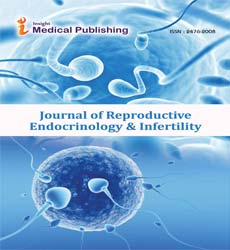The Hypothalamic–Pituitary–Gonadal Axis in Reproductive Endocrinology: Clinical Implications
Juul Poulsen*
Department of Obstetrics and Gynecology, Thomas Jefferson University Hospital, Philadelphia, PA, USA
Published Date: 2025-02-28Juul Poulsen*
Department of Obstetrics and Gynecology, Thomas Jefferson University Hospital, Philadelphia, PA, USA
Corresponding author:
Juul Poulsen,
Department of Obstetrics and Gynecology, Thomas Jefferson University Hospital, Philadelphia, PA, USA,
E-mail: juul@poulsen.edu
Received date: February 01, 2025, Manuscript No. ipjrei-25-20623; Editor assigned date: February 03, 2025, PreQC No. ipjrei-25-20623 (PQ); Reviewed date: February 15, 2025, QC No. ipjrei-25-20623; Revised date: February 22, 2025, Manuscript No. ipjrei-25-20623 (R); Published date: February 28, 2025, DOI: 10.36648/ipwhrm.10.1.70
Citation: Poulsen J (2025) The Hypothalamic–Pituitary–Gonadal Axis in Reproductive Endocrinology: Clinical Implications. J Reprod Endocrinol Infert Vol.10 No.1: 70.
Introduction
The hypothalamicâ??pituitaryâ??gonadal (HPG) axis is a central neuroendocrine regulatory system that governs human reproduction, sexual development, and fertility. Through a tightly orchestrated interplay of gonadotropin-releasing hormone (GnRH) secretion from the hypothalamus, luteinizing hormone (LH) and follicle-stimulating hormone (FSH) release from the pituitary, and sex steroid production by the gonads, the HPG axis ensures normal reproductive function. Disruptions at any level of this axis can lead to infertility, delayed or precocious puberty, menstrual irregularities, or hypogonadism, making its clinical understanding vital in reproductive endocrinology [1].
Description
The HPG axis operates through pulsatile GnRH release from the hypothalamus, which stimulates the anterior pituitary to secrete LH and FSH. These gonadotropins act on the testes in men to regulate spermatogenesis and testosterone production, and on the ovaries in women to support follicular maturation, ovulation, and the synthesis of estrogen and progesterone. Feedback mechanisms mediated by sex steroids and inhibin tightly regulate this cycle to maintain hormonal balance. Clinical disturbances in the GnRH pulse generator or pituitary responsiveness can impair this delicate rhythm, leading to reproductive disorders [2]. In women, abnormalities of the HPG axis commonly manifest as ovulatory dysfunction, polycystic ovary syndrome (PCOS), hypothalamic amenorrhea, or luteal phase defects. For example, reduced GnRH pulsatility due to stress, malnutrition, or excessive exercise can suppress gonadotropin secretion, leading to anovulation and infertility. Conversely, excessive LH secretion in PCOS disrupts follicular development, contributing to infertility and hyperandrogenism. In men, HPG axis dysfunction can present as hypogonadotropic hypogonadism, impaired spermatogenesis, or testosterone deficiency, with downstream effects on sexual function and fertility [3]. Clinically, evaluation of the HPG axis involves assessment of serum gonadotropins, sex steroid levels, and dynamic stimulation tests. Imaging of the hypothalamicâ??pituitary region may be warranted in suspected structural or functional defects. Therapeutic interventions target the underlying site of dysfunction: pulsatile GnRH therapy for hypothalamic disorders, gonadotropin injections for pituitary insufficiency, or pharmacological modulation of sex steroid feedback in conditions such as PCOS and endometriosis. In assisted reproductive technology (ART), controlled ovarian stimulation directly manipulates the HPG axis, highlighting its central role in clinical fertility treatments [5].
Conclusion The hypothalamicâ??pituitaryâ??gonadal axis is fundamental to reproductive endocrinology, integrating neuroendocrine signaling with gonadal function to regulate fertility. Disruptions in this axis underlie a wide spectrum of reproductive disorders in both men and women, emphasizing the importance of precise clinical evaluation and targeted therapies. Therapeutic interventions target the underlying site of dysfunction: pulsatile GnRH therapy for hypothalamic disorders, gonadotropin injections for pituitary insufficiency, or pharmacological modulation of sex steroid feedback in conditions such as PCOS and endometriosis Advances in diagnostic tools and reproductive interventions continue to refine the management of HPG axis dysfunction, ultimately improving outcomes for patients with infertility and endocrine-related reproductive conditions.
Acknowledgement None
Conflict of Interest None
References
- Mulhall JP, Goldstein I, Bushmakin AG, Cappelleri JC, Hvidsten K (2007) Validation of the erection hardness score. J Sex Med 4: 1626-1634
Google Scholar Cross Ref Indexed at
- Meistrich ML (2009) Male gonadal toxicity. Pediatr Blood Cancer 53: 261-266
Google Scholar Cross Ref Indexed at
- Trost LW, Brannigan RE (2012) Oncofertility and the male cancer patient. Curr Treat Options Oncol 13: 146-160
Google Scholar Cross Ref Indexed at
- Behre HM (2019) Clinical use of FSH in male infertility. Front Endocrinol 10: 322
Google Scholar Cross Ref Indexed at
- Kordzadeh A, Liu MO, Jayanthi NV (2017) Male infertility following inguinal hernia repair: A systematic review and pooled analysis. Hernia 21: 1-7
Google Scholar Cross Ref Indexed at
Open Access Journals
- Aquaculture & Veterinary Science
- Chemistry & Chemical Sciences
- Clinical Sciences
- Engineering
- General Science
- Genetics & Molecular Biology
- Health Care & Nursing
- Immunology & Microbiology
- Materials Science
- Mathematics & Physics
- Medical Sciences
- Neurology & Psychiatry
- Oncology & Cancer Science
- Pharmaceutical Sciences
